Unconfined Compressive Properties of Fiber-Stabilized Coastal Cement Clay Subjected to Freeze–Thaw Cycles
Abstract
1. Introduction
2. Test Overview
2.1. Testing Materials
2.2. Experimental Program
2.3. Sample Preparation and Testing
- (1)
- The clay sample was prepared by sieving through a sieve with an aperture of 1 mm. Raw materials (cement, fiber, clay and water) were weighed based on the proposed test scheme. The initial moisture content was measured, and the water needed was calculated based on designed mix ratios. The cement content, fiber content, and water content used in preparing the sample was 20%, 1% and 80%, respectively, by percentage of dry clay weight.
- (2)
- The weighed materials were well mixed in an automatic mixing bowl and sealed with a plastic bag. In the PCC preparation, water was added two times in order to ensure the uniformity of the mix. After cement was poured into the mixing tank, half a portion of the water was then added and well mixed. The final step of mixing was followed by adding the fiber into the mix; the remaining portion of water was then added and evenly mixed to ensure homogeneity of the mixing.
- (3)
- The mixture, which was evenly mixed and then placed in a plastic bag, was then carefully squeezed into the cylindrical mold with a diameter of 39.1 mm and height of 80 mm in four layers. Manual compaction was required for each layer of clay placed into the mold by vibrating the mold twenty times by hand to ensure no trapped air was in the cement clay. This step is repeated until the mold is fully filled.
- (4)
- After flattening the excessive clay sample with an aluminum scraper, the sample was left vertically in position for approximately 30 min. Then, both ends of the sample were wrapped with filter paper and marked. In addition, the prepared samples were placed horizontally into a water tank for curing at room temperature and subjected to an unconfined compressive strength test on the scheduled curing day.
2.4. Freeze–Thaw Cycle Test
3. Test Results and Analysis
3.1. The Influence of Curing Age
3.2. The Influence of Freeze–Thaw Cycles
3.3. The Degree of Damage
3.4. Failure Mode of Cemented Clay
4. Microscopic Analysis
5. Conclusions and Discussions
5.1. Conclusions
5.2. Discussions
Author Contributions
Funding
Institutional Review Board Statement
Informed Consent Statement
Data Availability Statement
Conflicts of Interest
References
- Jan, O.Q.; Mir, B.A. Strength behaviour of cement stabilised dredged clay. Int. J. Geosynth. Ground Eng. 2018, 4, 4–16. [Google Scholar] [CrossRef]
- Wang, W.; Zhang, C.; Li, N.; Tao, F.F. Characterisation of nano magnesia-cement-reinforced seashore soft clay by direct-shear test. Marine Georesources Geotechnol. 2019, 37, 989–998. [Google Scholar] [CrossRef]
- Jia, L.; Guo, J.; Jiang, Y.B.; Fu, Y.; Zhou, Z.D.; Lim, S.M.; Zhao, X.S. Experimental investigation on shear strength parameters of lime stabilized loess. Sustainability 2019, 11, 5397. [Google Scholar] [CrossRef]
- Jia, L.; Zhang, L.; Guo, J.; Yao, K.; Lim, S.M.; Li, B.; Xu, H. Evaluation on strength properties of lime-slag stabilized loess as pavement base material. Sustainability 2019, 11, 4099. [Google Scholar] [CrossRef]
- Li, N.; Zhu, Q.Y.; Wang, W.; Song, F.; An, D.L.; Yan, H.R. Compression characteristics and microscopic mechanism of coastal clay modified with cement and fly ash. Materials 2019, 12, 3182. [Google Scholar] [CrossRef] [PubMed]
- Wang, W.; Zhang, C.; Guo, J.; Li, N.; Li, Y.; Zhou, Z.; Liu, Y. Investigation on the triaxial mechanical characteristics of cement-treated subgrade clay admixed with polypropylene fiber. Appl. Sci. 2019, 9, 4557. [Google Scholar] [CrossRef]
- Khoshsirat, V.; Bayesteh, H.; Sharifi, M. Effect of high salinity in grout on the performance of cement-stabilized marine clay. Constr. Build. Mater. 2019, 217, 93–107. [Google Scholar] [CrossRef]
- Mollamahmutoglu, M.; Avcı, E. Cement type effect on improvement of clayey clay properties. ACI Mater. J. 2018, 115, 855–866. [Google Scholar]
- Yao, K.; Li, N.; Chen, D.H.; Wang, W. Generalized hyperbolic formula capturing curing period effect on strength and stiffness of cemented clay. Constr. Build. Mater. 2019, 199, 63–71. [Google Scholar] [CrossRef]
- Gao, L.; Ren, Z.; Yu, X. Experimental study of nanometer magnesium oxide-modified clay. Mech. Found. Eng. 2015, 52, 218–224. [Google Scholar] [CrossRef]
- Wang, W.; Li, Y.; Yao, K.; Li, N.; Zhou, A.Z.; Zhang, C. Strength properties of nano-MgO and cement stabilized coastal silty clay subjected to sulfuric acid attack. Marine Georesources Geotechnol. 2020, 38, 1177–1186. [Google Scholar] [CrossRef]
- Tebaldi, G.; Orazi, M.; Orazi, U.S. Effect of freeze-thaw cycles on mechanical behavior of lime-stabilized clay. J. Mater. Civil Eng. 2016, 28, 06016002. [Google Scholar] [CrossRef]
- Orakoglu, M.E.; Liu, J. Effect of freeze-thaw cycles on triaxial strength properties of fiber-reinforced clayey clay. KSCE J. Civil Eng. 2017, 21, 2128–2140. [Google Scholar] [CrossRef]
- Kumar, A.; Soni, D.K. Study of the mechanical behaviour of a clayey clay under normal and frozen conditions. Slovak J. Civil Eng. 2019, 27, 29–35. [Google Scholar] [CrossRef]
- Tajdini, M.; Bonab, M.H.; Golmohamadi, S. An experimental investigation on effect of adding natural and synthetic fibres on mechanical and behavioural parameters of clay–cement materials. Int. J. Civil Eng. 2018, 16, 353–370. [Google Scholar] [CrossRef]
- Xu, J.; Ren, J.; Wang, Z.; Wang, S.; Yuan, J. Strength behaviors and meso-structural characters of loess after freeze-thaw. Cold Reg. Sci. Technol. 2018, 148, 104–120. [Google Scholar] [CrossRef]
- Ji, L.Q.; Wei, M.A. Influence of freezing-thawing on strength of overconsolidated clays. Chin. J. Geotech. Eng. 2006, 28, 2082–2086. [Google Scholar]
- Zhang, W.; Ma, J.; Tang, L. Experimental study on shear strength characteristics of sulfate saline clay in Ningxia region under long-term freeze-thaw cycles. Cold Reg. Sci. Technol. 2019, 160, 48–57. [Google Scholar] [CrossRef]
- Zhong, J.; Shi, J.; Shen, J.; Zhou, G.; Wang, Z. Investigation on the failure behavior of engineered cementitious composites under freeze-thaw cycles. Materials 2019, 12, 1808. [Google Scholar] [CrossRef]
- Wang, F.; Ping, X.; Zhou, J.; Kang, T. Effects of crumb rubber on the frost resistance of cement-clay. Constr. Build. Mater. 2019, 223, 120–132. [Google Scholar] [CrossRef]
- Kravchenko, E.; Liu, J.; Niu, W.; Zhang, S. Performance of clay reinforced with fibers subjected to freeze-thaw cycles. Cold Reg. Sci. Technol. 2018, 153, 18–24. [Google Scholar] [CrossRef]
- Amini, O.; Ghasemi, M. Laboratory study of the effects of using magnesium slag on the geotechnical properties of cement stabilized clay. Constr. Build. Mater. 2019, 223, 409–420. [Google Scholar] [CrossRef]
- Bekhiti, M.; Trouzine, H.; Rabehi, M. Influence of waste tire rubber fibers on swelling behavior, unconfined compressive strength and ductility of cement stabilized bentonite clay clay. Constr. Building Mater. 2019, 208, 304–313. [Google Scholar] [CrossRef]
- Yao, K.; An, D.; Wang, W.; Li, N.; Zhang, C.; Zhou, A.Z. Effect of nano-MgO on mechanical performance of cement stabilized silty clay. Marine Georesources Geotechnol. 2020, 38, 250–255. [Google Scholar] [CrossRef]
- Yao, K.; Wang, W.; Li, N.; Zhang, C.; Wang, L.X. Investigation on strength and microstructure characteristics of nano-MgO admixed with cemented soft clay. Constr. Build. Mater. 2019, 206, 160–168. [Google Scholar] [CrossRef]
- Ouhadi, V.R.; Yong, R.N.; Amiri, M. Pozzolanic consolidation of stabilized soft clays. Appl. Clay Sci. 2014, 95, 111–118. [Google Scholar] [CrossRef]
- Zaimoglu, A.S.; Tan, O.; Akbulut, R.K. Optimization of consistency limits and plasticity index of fine-grained clays modified with polypropylene fibers and additive materials. KSCE J. Civil Eng. 2016, 20, 662–669. [Google Scholar] [CrossRef]
- Mahrous, M.A.; Segvic, B.; Zanoni, G.; Khadka, S.D.; Senadheera, S.; Jayawickrama, P.W. The role of clay swelling and mineral neoformation in the stabilization of high plasticity soils treated with the fly ash- and metakaolin-based geopolymers. Minerals 2018, 8, 146. [Google Scholar] [CrossRef]
- Consoli, N.C.; Bassani, M.A.A.; Festugato, L. Effect of fiber-reinforcement on the strength of cemented clays. Geotext. Geomembr. 2010, 28, 344–351. [Google Scholar] [CrossRef]
- Jiang, P.; Mao, T.; Li, N.; Jia, L.; Zhang, F.; Wang, W. Characterization of short-term strength properties of fiber/cement-modified slurry. Adv. Civil Eng. 2019, 3789403. [Google Scholar] [CrossRef]
- Hamidi, A.; Hooresfand, M. Effect of fiber reinforcement on triaxial shear behavior of cement treated sand. Geotext. Geomembr. 2013, 36, 1–9. [Google Scholar] [CrossRef]
- Boz, A.; Sezer, A. Influence of fiber type and content on freeze-thaw resistance of fiber reinforced lime stabilized clay. Cold Reg. Sci. Technol. 2018, 151, 359–366. [Google Scholar] [CrossRef]
- Benchiheub, D.; Amouri, C.; Houari, H.; Belachia, M. Effect of natural pozzolana and polypropylene fibers on the performance of lime mortar for old buildings restoration. J. Adhes. Sci. Technol. 2018, 32, 1324–1340. [Google Scholar] [CrossRef]
- Al-mashhadani, M.M.; Canpolat, O.; Aygörmez, Y.; Uysal, M.; Erdem, S. Mechanical and microstructural characterization of fiber reinforced fly ash based geopolymer composites. Constr. Building Mater. 2018, 167, 505–513. [Google Scholar] [CrossRef]
- Ding, M.; Zhang, F.; Ling, X.; Lin, B. Effects of freeze-thaw cycles on mechanical properties of polypropylene fiber and cement stabilized clay. Cold Reg. Sci. and Technol. 2018, 154, 155–165. [Google Scholar] [CrossRef]
- Orakoglu, M.E.; Liu, J.; Niu, F. Dynamic behavior of fiber-reinforced clay under freeze-thaw cycles. Clay Dyn. Earthq. Eng. 2017, 101, 269–284. [Google Scholar] [CrossRef]
- Chaduvula, U.; Desai, A.K.; Solanki, C.H. Application of triangular polypropylene fibres on clay subjected to freeze–thaw cycles. Indian Geotech. J. 2014, 44, 351–356. [Google Scholar] [CrossRef]
- Tran, K.Q.; Satomi, T.; Takahashi, H. Improvement of mechanical behavior of cemented soil reinforced with waste cornsilk fibers. Constr. Build. Mater. 2018, 178, 204–210. [Google Scholar] [CrossRef]
- Yang, B.H.; Weng, X.Z.; Liu, J.Z.; Kou, Y.N.; Jiang, L.; Li, H.L.; Yan, X.C. Strength characteristics of modified polypropylene fiber and cement-reinforced loess. J. Cent. South Univ. 2017, 24, 560–568. [Google Scholar] [CrossRef]
- Hu, W.L.; He, P.L.; Liu, H. Experimental study on optimization of shear strength parameters of basalt fiber loess. Chinese J. Geol. Hazard Control 2019, 30, 92–97. [Google Scholar]
- Chen, Q.Q.; Yao, K.; Liu, Y. Stress-dependent behavior of marine clay admixed with fly-ash-blended cement. Int. J. Pavement Res. Technol. 2018, 11, 611–616. [Google Scholar] [CrossRef]
- Chinese National Geotechnical Test Standard; GB/T 50123-1999; Nanjing Hydraulic Research Institute : Nanjing, China, 1999.
- Zhou, Z.; Xing, K.; Yang, H.; Wang, H. Damage mechanism of soil-rock mixture after freeze-thaw cycles. J. Cent. South Univ. 2019, 26, 13–24. [Google Scholar] [CrossRef]
- Dai, M.X.; Zhang, C.K.; He, Y.L.; Fang, L.Q.; Han, C.P. Shear strength analysis of polypropylene fiber soil under freeze-thaw cycles. Constr. Technol. 2018, 47, 1125–1130. [Google Scholar]
- He, M.M. Experimental Study on Mechanical Properties of Fiber Loess under Freeze-Thaw Cycles; Xi’an University of Technology: Xi’an, China, 2019; Volume 1. [Google Scholar]
- Wu, W.Y. UCS Experiment and Microscopic Mechanism of Modified Seashore Soft Soil under Freeze-Thaw Environment; Shaoxing University: Shaoxing, China, 2019; Volume 3. [Google Scholar]
- Roy, A.M. Effects of interfacial stress in phase field approach for martensitic phase transformation in NiAl shape memory alloys. Appl. Phys. A 2020, 126, 576. [Google Scholar] [CrossRef]
- Arunabha, M.R. Influence of Interfacial Stress on Microstructural Evolution in NiAl Alloys. JETP Lett. 2020, 112, 173–179. [Google Scholar]



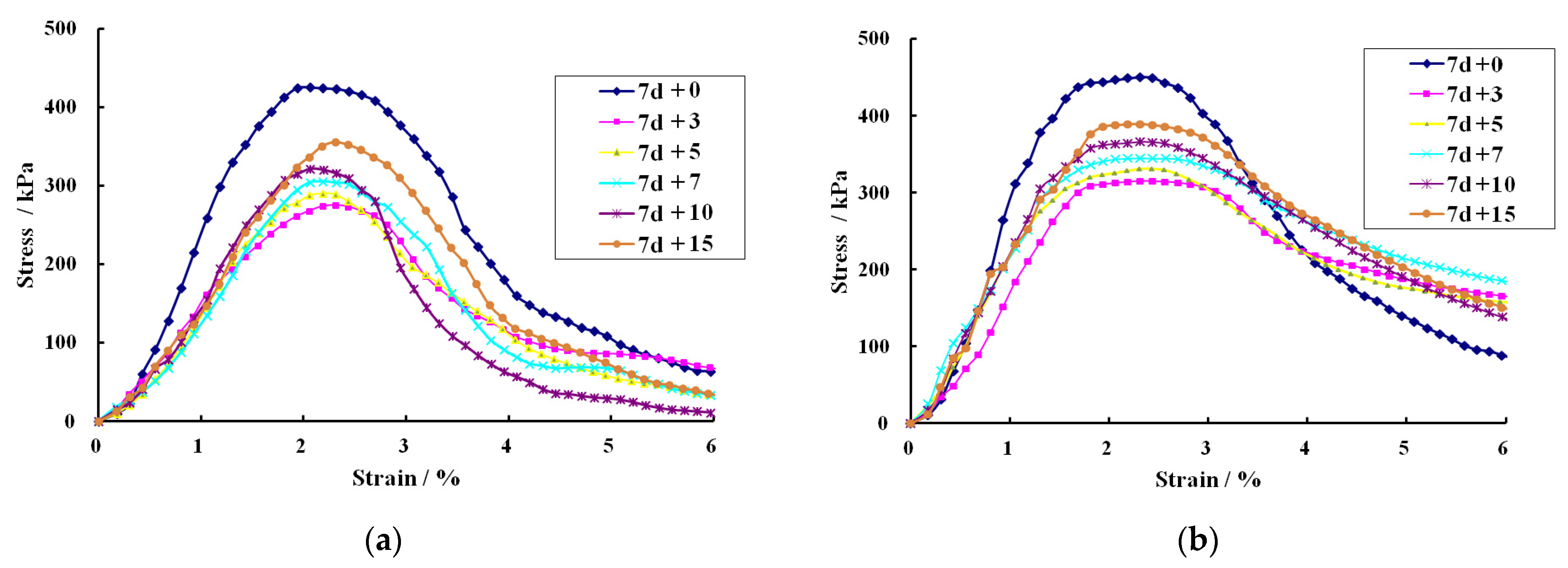
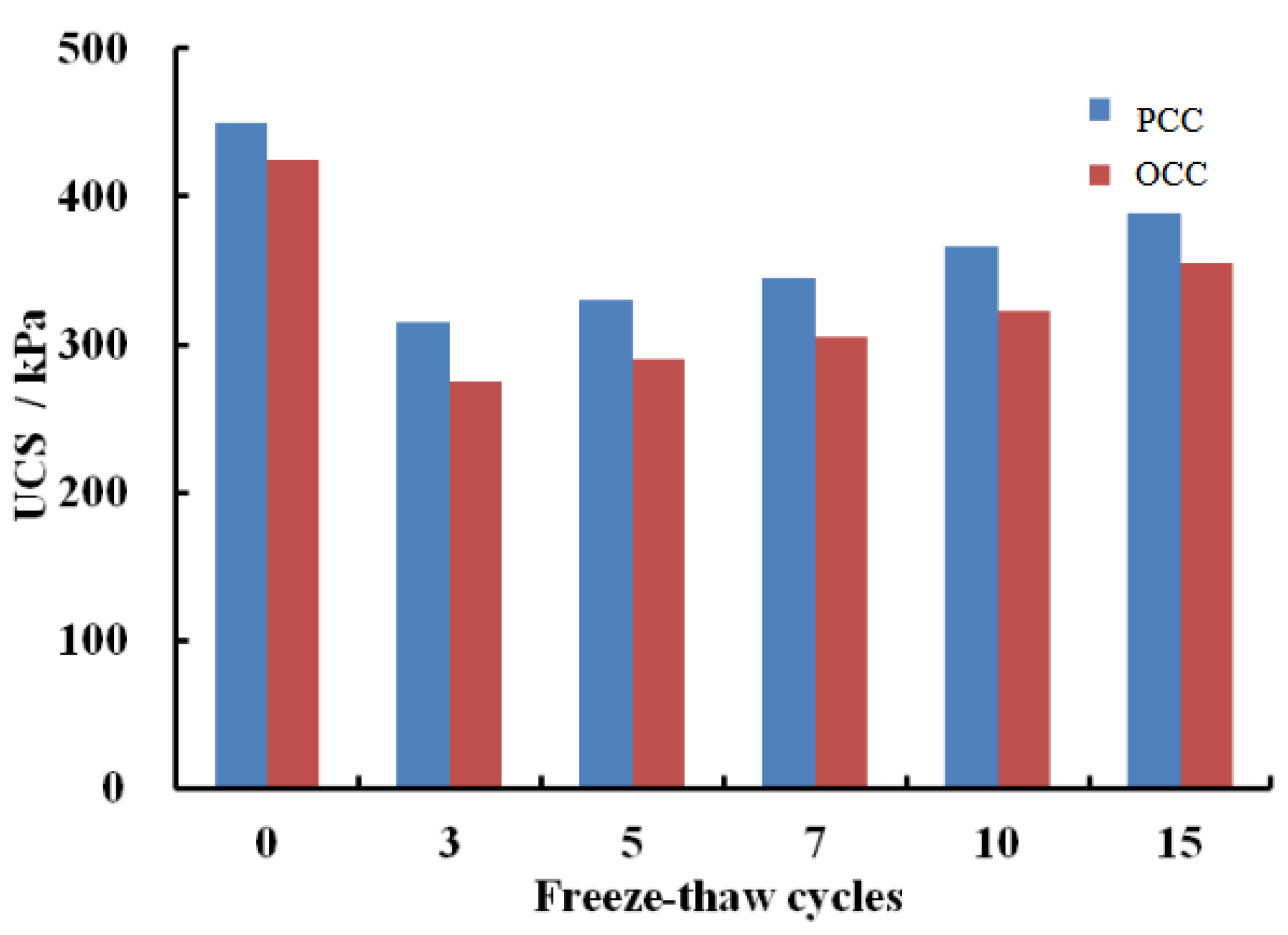
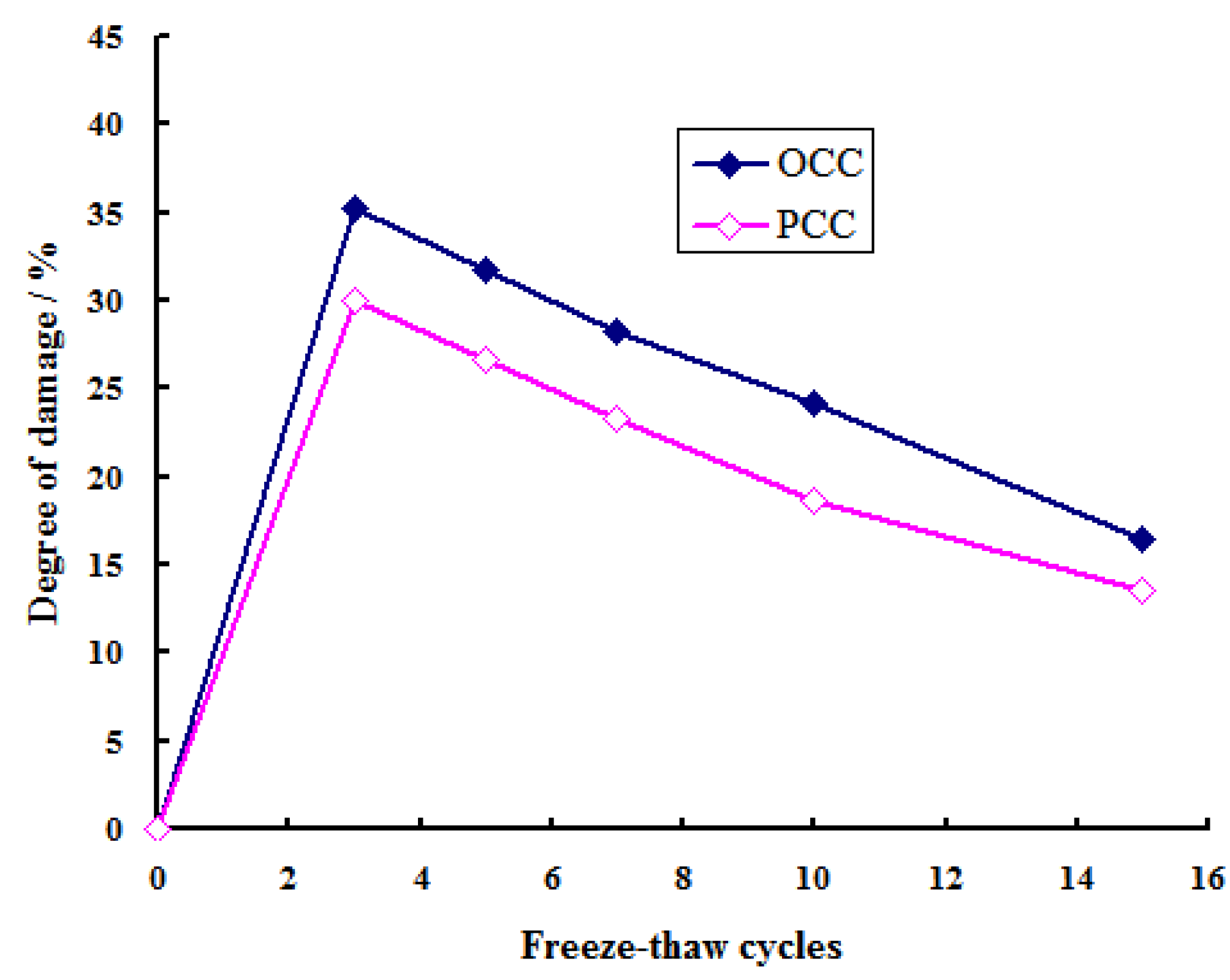
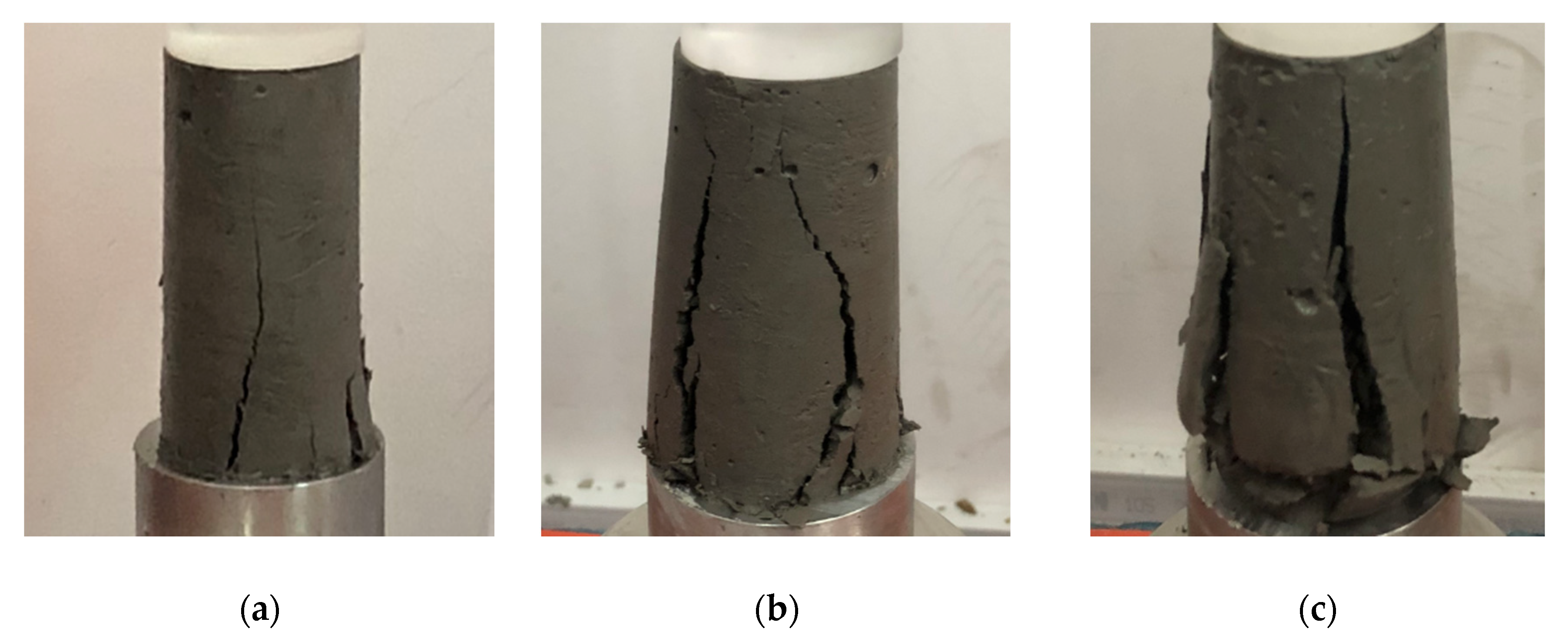

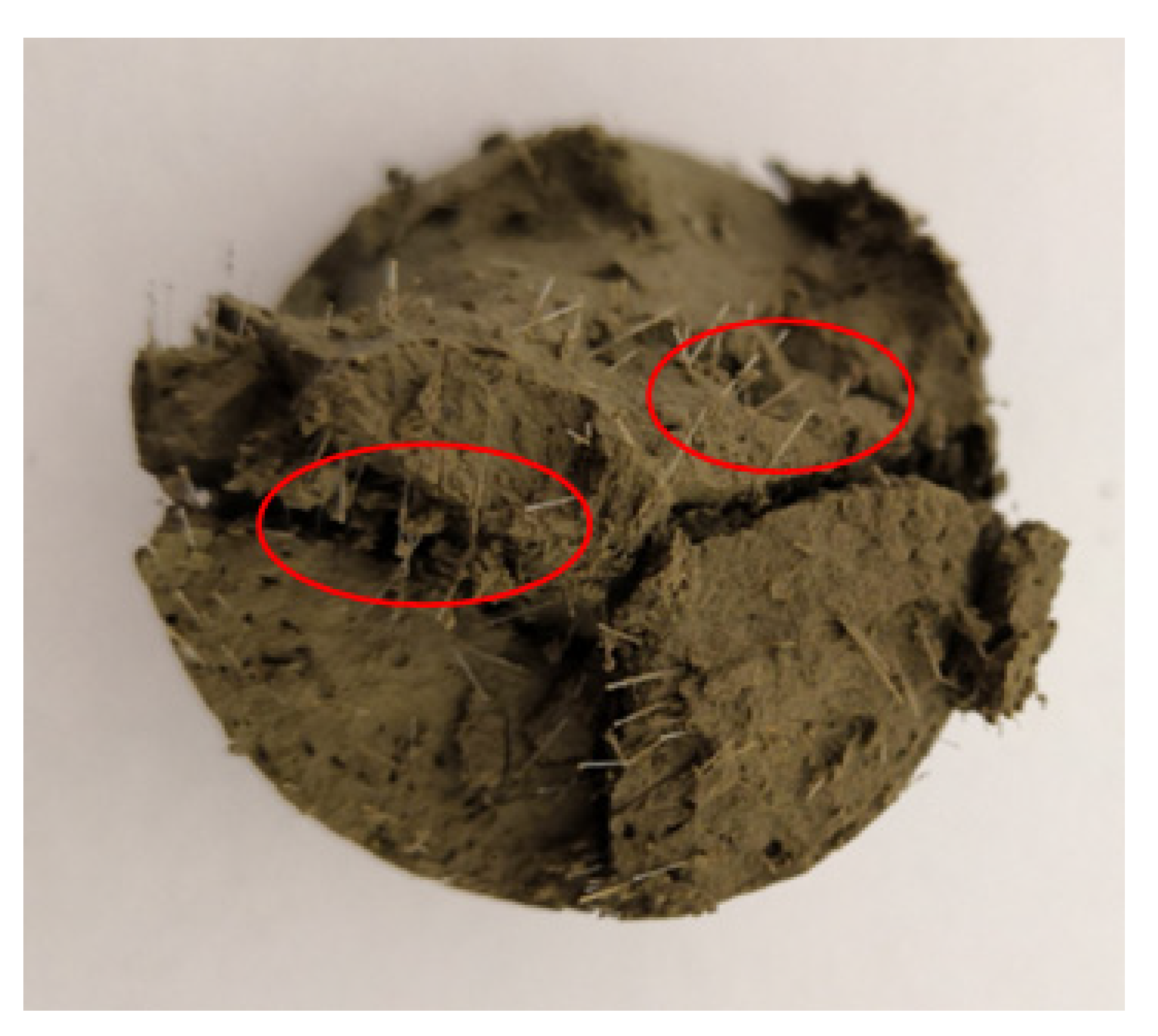
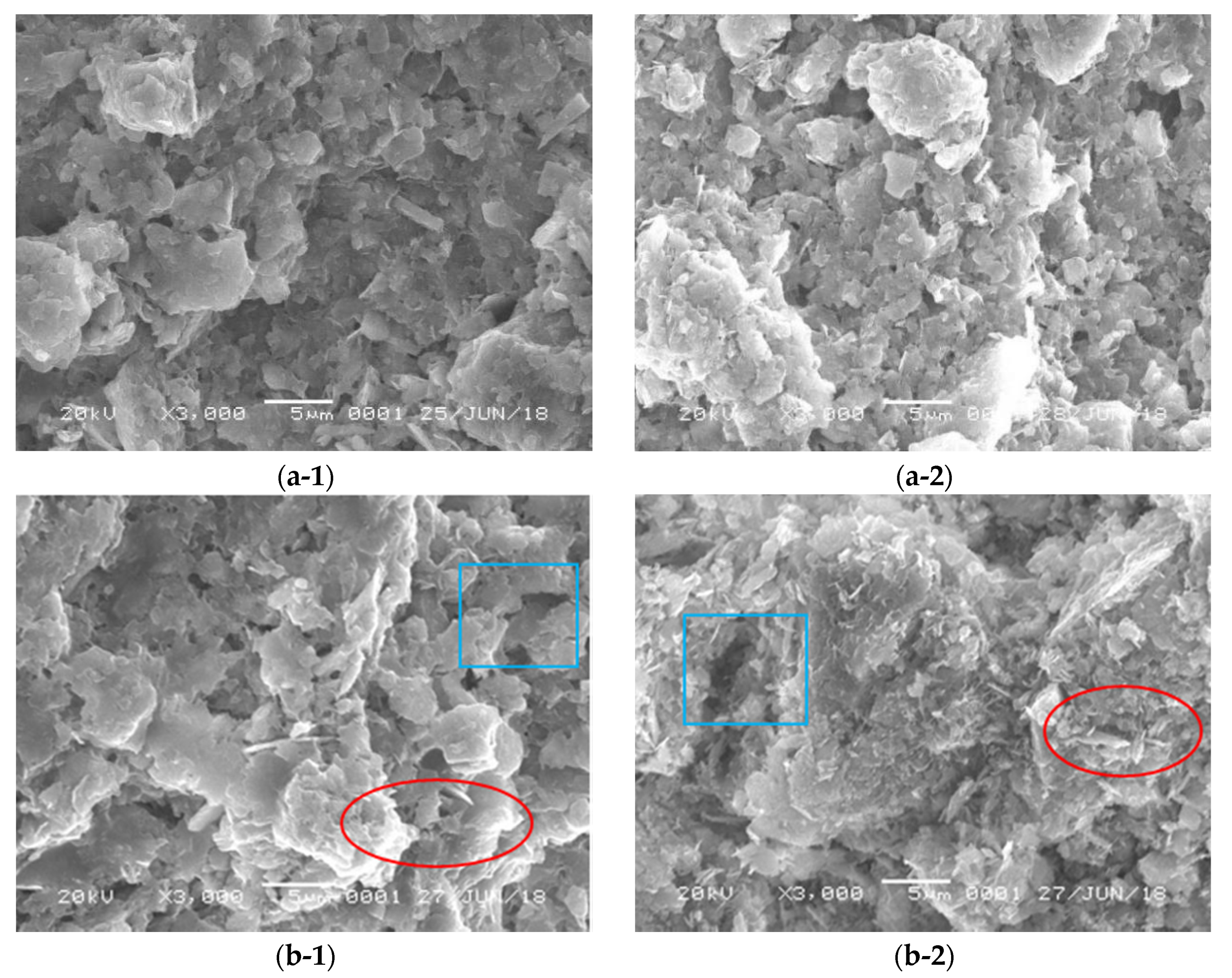
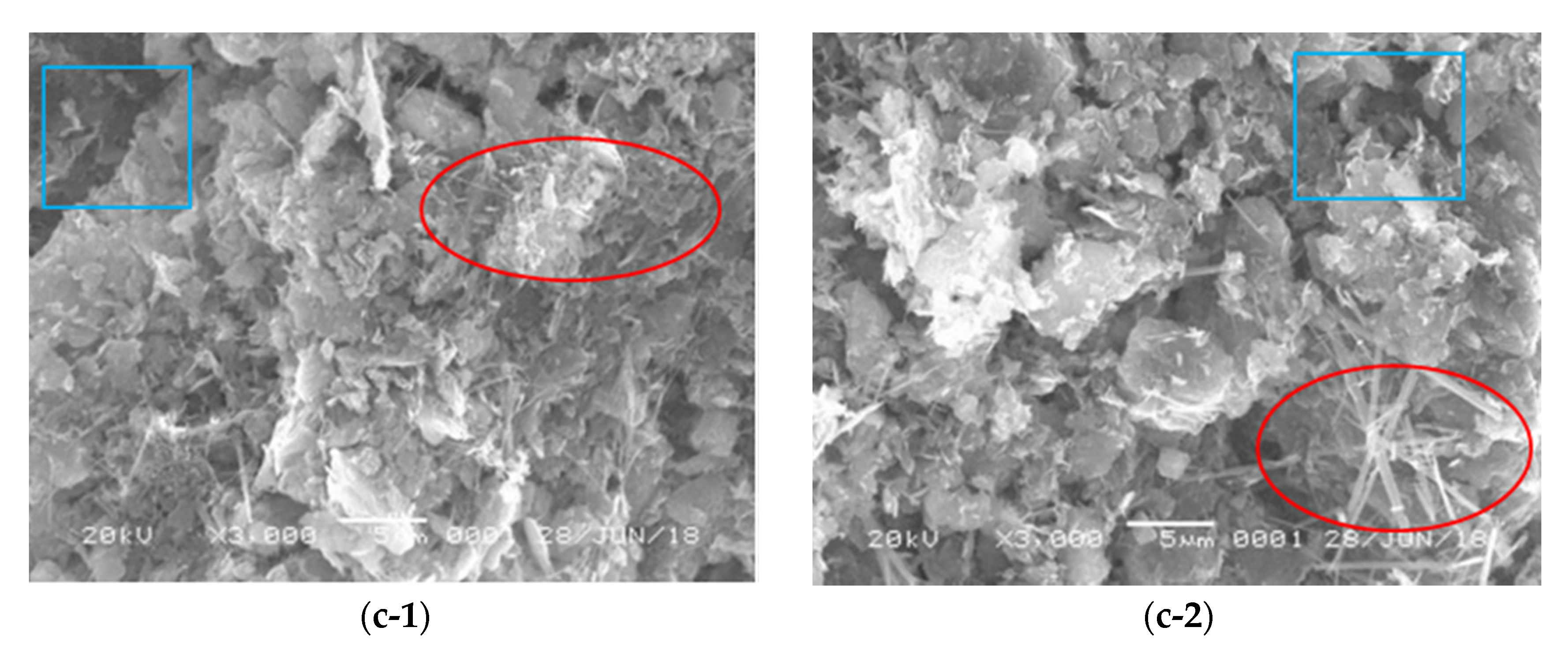

| Wet Density ρ /g·cm−3 | Moisture Content ω /% | Plastic Limit ωP /% | Liquid Limit ωL /% | Plasticity Index IP | Liquidity Index IL | Compression Coefficient α /MPa | Compression Modulus Es /MPa |
|---|---|---|---|---|---|---|---|
| 1.89 | 58 | 30 | 43.5 | 13.5 | 0.23 | 0.77 | 2.25 |
| Specific Gravity | Diameter /μm | Length /mm | Tensile Strength /MPa | Elasticity Modulus /Mpa | Fusing Point /℃ | Ignition Point /℃ | Limit Tensile |
|---|---|---|---|---|---|---|---|
| 0.91 | 18–8 | 6 | >358 | >3500 | >165 | 590 | >150% |
| Test Sample | Cement Content /% | Moisture Content /% | Modified Material Content /% | Curing Age /d |
|---|---|---|---|---|
| OCC | 20 | 80 | 0 | 7, 10, 12, 14, 17, 22 |
| PCC | PPF-1% |
| Test Sample | Cement Content /% | Moisture Content /% | Modified Material Content /% | Curing Age /d | Cycles of Freeze–Thaw Cycles /Number |
|---|---|---|---|---|---|
| OCC | 20 | 80 | 0 | 7 | 3, 5, 7, 10, 15 |
| PCC | PPF-1% |
| Curing Age /d | 7 | 10 | 12 | 14 | 17 | 22 |
|---|---|---|---|---|---|---|
| UCS /kPa | 425 | 464 | 509 | 565 | 621 | 666 |
| Strain /% | 2.06 | 2.07 | 2.11 | 2.06 | 2.07 | 2.18 |
| Curing Age/d | 7 | 10 | 12 | 14 | 17 | 22 |
|---|---|---|---|---|---|---|
| UCS /kPa | 450 | 546 | 592 | 646 | 688 | 731 |
| Strain /% | 2.31 | 2.44 | 2.44 | 2.44 | 2.44 | 2.44 |
Publisher’s Note: MDPI stays neutral with regard to jurisdictional claims in published maps and institutional affiliations. |
© 2021 by the authors. Licensee MDPI, Basel, Switzerland. This article is an open access article distributed under the terms and conditions of the Creative Commons Attribution (CC BY) license (http://creativecommons.org/licenses/by/4.0/).
Share and Cite
Li, N.; Zhu, Y.; Zhang, F.; Lim, S.M.; Wu, W.; Wang, W. Unconfined Compressive Properties of Fiber-Stabilized Coastal Cement Clay Subjected to Freeze–Thaw Cycles. J. Mar. Sci. Eng. 2021, 9, 143. https://doi.org/10.3390/jmse9020143
Li N, Zhu Y, Zhang F, Lim SM, Wu W, Wang W. Unconfined Compressive Properties of Fiber-Stabilized Coastal Cement Clay Subjected to Freeze–Thaw Cycles. Journal of Marine Science and Engineering. 2021; 9(2):143. https://doi.org/10.3390/jmse9020143
Chicago/Turabian StyleLi, Na, Yalan Zhu, Fang Zhang, Sin Mei Lim, Wangyi Wu, and Wei Wang. 2021. "Unconfined Compressive Properties of Fiber-Stabilized Coastal Cement Clay Subjected to Freeze–Thaw Cycles" Journal of Marine Science and Engineering 9, no. 2: 143. https://doi.org/10.3390/jmse9020143
APA StyleLi, N., Zhu, Y., Zhang, F., Lim, S. M., Wu, W., & Wang, W. (2021). Unconfined Compressive Properties of Fiber-Stabilized Coastal Cement Clay Subjected to Freeze–Thaw Cycles. Journal of Marine Science and Engineering, 9(2), 143. https://doi.org/10.3390/jmse9020143







